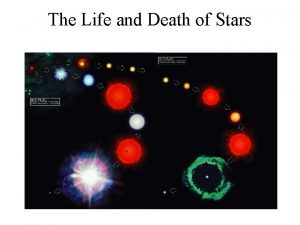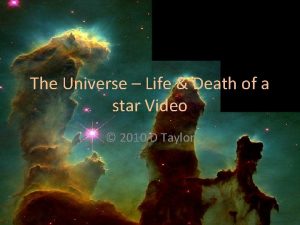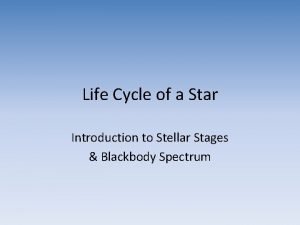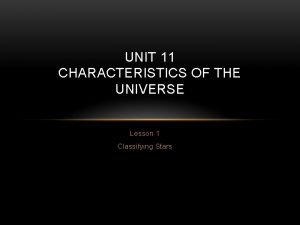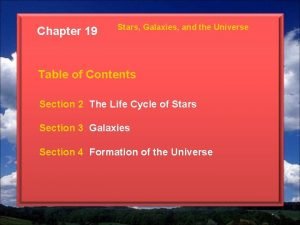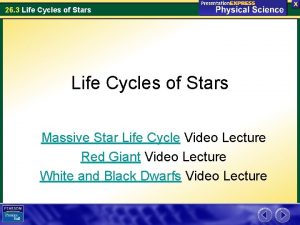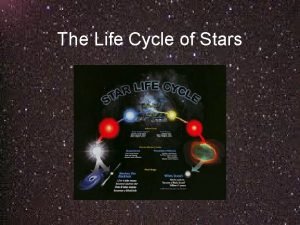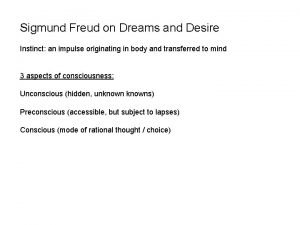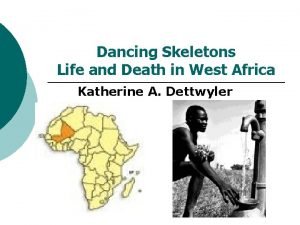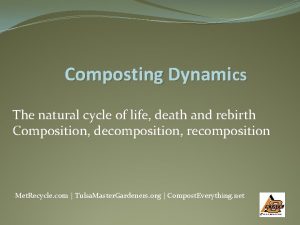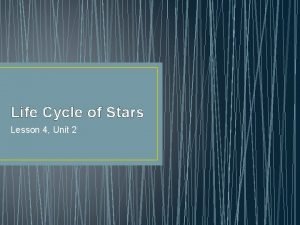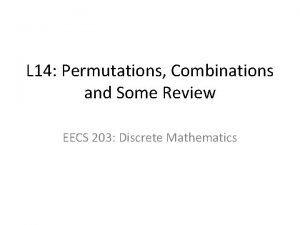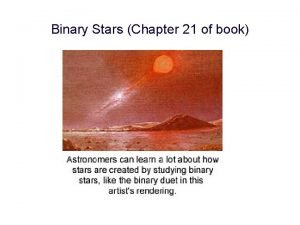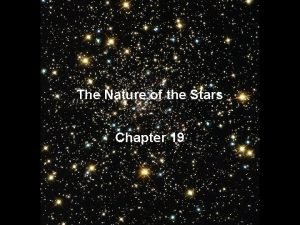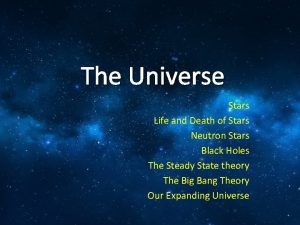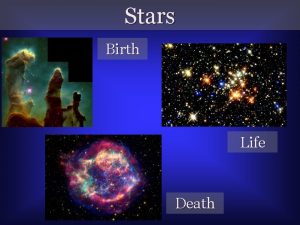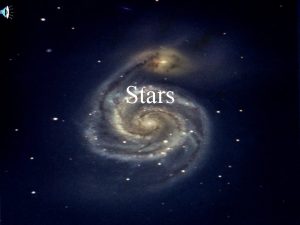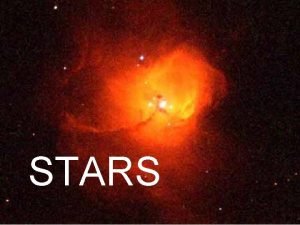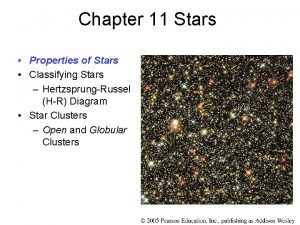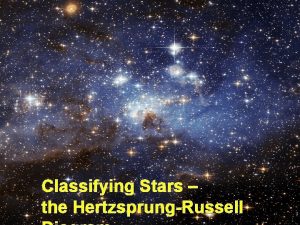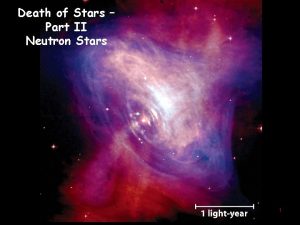The Life and Death of Stars What is





















































































- Slides: 85

The Life and Death of Stars

What is a Star? • A star is a sphere of plasma gas that fuses atomic nuclei in its core and so emits light • The name star can also be tagged onto a body that is somewhere on the star evolution process e. g. proto-star, neutron star.

Stellar Evolution • • • Stars begin as a nebula of gas and dust. Protostar- gravity pulls it together, temperature rises. Main Sequence- Temperature, color, luminosity, & size are directly proportional to the mass. Red Giant or Supergiant- large, luminous, low temp. Ending is based on initial mass and can be either: – A Planetary nebula- outer layers of star blown off causing a: White Dwarf- small, dim, white star with high temperature. OR/ – A Supernova- star explodes leaving a: Neutron Star (Pulsar is one type)- only has neutrons, or a Black Hole- so small and dense that even light cannot escape it.

Star Birth

Stages of Star Birth • Our goals for learning • Where and Why do stars form? • What slows the contraction of a star-forming cloud? • How does nuclear fusion begin in a newborn star?

Where and Why do stars form?

Star-Forming Clouds • Stars form in dark clouds of dusty gas in interstellar space • The gas between the stars is called the interstellar medium

Molecular Clouds • • Most of the matter in star-forming clouds is in the form of molecules (H 2, CO, …) These molecular clouds have a temperature of 10 -30 K and a density of about 300 molecules per cubic cm

Fragmentation of a Cloud Gravity within a contracting gas cloud becomes stronger as the gas becomes denser random motions of different sections of the cloud cause it to become lumpy Each lump in which gravity can overcome pressure can become a star

What slows the contraction of a star-forming cloud?

Trapping of Thermal Energy • As contraction packs the molecules and dust particles of a cloud fragment closer together, it becomes harder for infrared and radio photons to escape • Thermal energy then begins to build up inside, increasing the internal pressure • Contraction slows down, and the center of the cloud fragment becomes a protostar

Conservation of Angular Momentum • • • Behaves just like solar system formation, The rotation speed of the cloud from which a star forms increases as the cloud contracts Heating, spinning and flattening occur

Examples of Proplyds in the Orion Nebula

In the animation's visible images, how do the protostars appear? A. They are bright points of light. B. They are bright fuzzy features. C. They are faint fuzzy features. D. They do not appear in the image.

How does nuclear fusion begin in a newborn star?

From Protostar to Main Sequence • Protostar looks starlike after the surrounding gas is blown away, but its thermal energy comes from gravitational contraction, not fusion • Contraction must continue until the core becomes hot enough for nuclear fusion • Contraction stops when the energy released by core fusion balances energy radiated from the surface—the star is now a main-sequence star

Birth Stages on a Life Track • Life track illustrates star’s surface temperature and luminosity at different moments in time

Assembly of a Protostar • Luminosity and temperature grow as matter collects into a protostar

2. Convective Contraction • Surface temperature remains near 3, 000 K while convection is main energy transport mechanism

3. Radiative Contraction • Luminosity remains nearly constant during late stages of contraction, while radiation is transporting energy through star

4. Self-Sustaining Fusion • Core temperature continues to rise until star arrives on the main sequence

Life Tracks for Different Masses • Models show that Sun required about 30 million years to go from protostar to main sequence • Higher-mass stars form faster • Lower-mass stars form more slowly

Open cluster: A few thousand loosely packed stars

What is the initial energy source for a contracting protostar? A. pressure B. gravitational potential energy C. fusion D. kinetic energy

What have we learned? • Where and why do stars form? – Stars form in dark, dusty clouds of molecular gas with temperatures of 10 -30 K – Stars form in clouds that are massive enough for gravity to overcome thermal pressure (and any other forms of resistance) – Such a cloud contracts and breaks up into pieces called proplyds that go on to form stars

What have we learned? • What slows the contraction of a star-forming cloud? – The contraction of a cloud fragment slows when thermal pressure builds up because infrared and radio photons can no longer escape • How does nuclear fusion begin in a newborn star? � Nuclear fusion begins when contraction causes the star’s core to grow hot enough for fusion

Forces Controlling Stars • Our goals for learning • How does nuclear fusion occur in stars? • What is thermal pressure? • What is degeneracy pressure? • How do these control the mass of a star?

How does nuclear fusion occur in stars?

High temperatures cause particles to smash together. Enables nuclear fusion to happen in the core

Sun releases energy by fusing four hydrogen nuclei into one helium nucleus Total mass is 0. 7% lower

Stable Star • Star’s core fuses hydrogen into helium, releasing energy. • The energy causes gas expansion pushing outward against the gravity pulling inward. This is called thermal pressure. • When the pressures balance, the star is in equilibrium and burns steadily.

Stellar Thermostat • The balancing act between thermal expansion pushing out and gravity contracting inward, forces the temperature to stay constant.

Stellar Thermostat If temperature falls because fusion rate drops : Thermal pressure drops, gravity gains =>core contracts and heats back up If temperature rises because fusion rate increases: Thermal pressure increases over gravity. =>core expands, which causes core to cool down

When star run out of fuel other atomic forces becomes important Pauli Exclusion Principal: Laws of quantum mechanics prohibit two electrons from occupying same state in same place

Electron Degeneracy Pressure • Electrons can never occupy the same state at the same time. • As a result, they cannot be completely crushed without being forced into each other, so they exert a force outward acting against gravity. • This is called degeneracy pressure.

Thermal Pressure: Depends on heat content The main form of pressure in most stars Degeneracy Pressure: Particles can’t be in same state in same place Doesn’t depend on heat content

How do these Forces Control the Mass of a Star?

– Low mass means low gravitational force so electrons are not crushed and degeneracy pressure is effective. – Fusion will not begin if contraction stops before the core temperature rises above 107 K. – At very high mass, high gravitational force causes extreme amounts of fusion and very high thermal and radiation pressure. – If radiation pressure is high, then star will be large. Too high and the star will explode

Limiting the Mass of Stars > 100 MSun • Radiation pressure so great, star blows apart Stable stars • Gravity and heat overcome degeneracy pressure in the core, core fuses - stars shine! < 0. 08 MSun • Degeneracy pressure supports the core of the star, no fusion! (MSun is the mass of the Sun)

Brown Dwarfs • Degeneracy pressure halts the contraction of objects with <0. 08 MSun before core temperature become hot enough for fusion • Starlike objects not massive enough to start fusion are brown dwarfs

What have we learned? • How does nuclear fusion occur in stars? – The core’s extreme temperature and density are just right for nuclear fusion of hydrogen to helium through the proton-proton chain – Gravitational equilibrium acts as a thermostat to regulate the core temperature because fusion rate is very sensitive to temperature

What have we learned? • What is thermal pressure? – hot gases moving more, cause expansion, which exerts an outward pressure inside a star • What is degeneracy pressure? – electrons cannot be at the same state at the same time and exert a repulsion force to prevent it from happening.

A star's life is a struggle between ____ wanting to crush it, and ____ wanting to expand it. A. gravity, nuclear energy B. gravity, convection C. gas pressure, radiation D. nuclear energy, radiation

Lives in the Balance • Our goals for learning • How does a star’s mass affect its life and death?

Stellar Mass and Life Path • High mass stars (> 8 MSun) end with an explosion • Lower mass stars < 4 MSun) end by material loss

Life as a Low-Mass Star • Our goals for learning • What are the final life stages of a low-mass star? • How does a low-mass star die?

Stellar Old-Age • A star remains on the main sequence as long as it can fuse hydrogen into helium in its core. • It starts to leave the main sequence once the core is mostly made of helium • Observations of star clusters show that a star becomes larger, redder, and brighter after its time on the main sequence is over.

The Changing Star • He is inert, so is generating no thermal pressure. => Core contracts • H begins fusing in a shell around the core. • Shell fusion is even more fast burning than before. => brightness increases • Thermal pressure increases. => Star expands into red giant

Feedback Loop • degeneracy pressure not thermal pressure now operates in the core. • The increasing fusion rate in the shell does not stop core contraction => Causes even more shell fusion, brightness and star expansion. • This is a runaway process until the core reaches a critical mass of helium.

Hot enough for Helium fusion : three He nuclei combine to make carbon Helium fusion does not begin right away because it requires higher temperatures than hydrogen fusion.

Helium Flash • Core temperature rises rapidly when helium fusion begins • Helium fusion rate skyrockets until thermal pressure takes over and expands core again. • The core has switched back on and the star contracts and burns evenly.

Helium burning stars neither shrink nor grow because core thermostat is temporarily fixed.

Life Track after Main Sequence • Changes in brightness or temperature show up on the H-R Diagram • Dying stars form their own branch away from the main sequence line

Life Track after Helium Flash • Models show that a red giant should shrink and become less luminous after helium fusion begins in the core

When a low-mass star can no longer fuse hydrogen into helium in its core_______ A. hydrogen fusion will begin in a shell around the core. B. helium will begin to fuse into carbon in the core. C. all fusion reactions stop and the star becomes a white dwarf. D. the outer layers of the star blow off in

As the helium core collapses; the luminosity _____, and the temperature ____. A. increases, increases B. increases, decreases C. decreases, stays the same D. stays the same, increases

How does a low-mass star die?

Double Shell Burning • The core fuses until a critical mass of inert carbon is in the core and helium fusion stops. • He fuses into carbon in a shell around the carbon core, and H fuses to He in a shell around the helium layer. • fusion rate spikes in a series of thermal pulses.

Planetary Nebulae • A final pulse ejects the H and He into space as a planetary nebula • The core left behind becomes a white dwarf

Planetary Nebulae Side view Angled view End view The apparent shape of a planetary nebula depends on the angle at which we see it.

End of Fusion • Fusion progresses no further in a low-mass star because the core temperature never grows hot enough for fusion of heavier elements (some He fuses to C to make oxygen) • Degeneracy pressure supports the white dwarf against gravity

Low-Mass Star Summary 1. Protostar 2. Main Sequence: H fuses to He in core 3. Red Giant: H fuses to He in shell around He core 4. Helium Core Burning: He fuses to C in core while H fuses to He in shell 5. Double Shell Burning: H and He both fuse in shells Not to scale! 6. Planetary Nebula leaves white dwarf behind

Life Track of a Sun-Like Star • Helium burning stars form a horizontal branch • Double shell burning stars are called Assymtotic Branch Giants (ABGs)

What have we learned? • How does a star’s mass affect its life? – Mass affects life length and how explosive the stars death becomes. • What are the life stages of a low-mass star? – H fusion in core (main sequence) – H fusion in shell around contracting core (red giant) – He fusion in core (horizontal branch) – Double-shell burning (red giant) • How does a low-mass star die? – Ejection of H and He in a planetary nebula leaves behind an inert white dwarf

Life as a High-Mass Star • Our goals for learning • What are the final life stages of a high-mass star? • How does a high-mass star die?

What are the life stages of a highmass star?

High-Mass Old Age • Late life stages of high-mass stars are similar to those of low-mass stars: – Hydrogen core fusion (main sequence) – Hydrogen shell burning (giant) – Helium core fusion (supergiant) – Feed-back loop continues with carbon core fusion

Helium Capture • stars with >4 MSun have core temperatures that allow helium to fuse to make heavier elements

Advanced Nuclear Burning • Core temperatures in stars with >8 MSun allow fusion of elements as heavy as iron

Multiple Shell Burning • Advanced nuclear burning proceeds in a series of nested shells • This is a Red Supergiant

Life Tracks of High Mass Stars

How does a high-mass star die?

• Iron is a dead end for fusion because nuclear reactions involving iron do not release energy • (Fe has lowest mass per nuclear particle)

• In an >8 MSun star, iron builds up in core until degeneracy pressure is overwhelmed. • The core suddenly collapses, then core bounce causes a supernova explosion

Type II Supernova Explosion • Core degeneracy pressure goes away because electrons combine with protons, making neutrons and neutrinos • Neutrons collapse to the center, forming a neutron star

Supernova Remnant • Energy released by collapse of core drives outer layers into space • Heavier elements are created in the explosion.

Energy and neutrons released in supernova explosion enable elements heavier than iron to form, including Au and U

Supernova Remnant • Energy released by collapse of core drives outer layers into space • The Crab Nebula is the remnant of the supernova seen in A. D. 1054

Neutron stars are barely as large as a small town

Life Stages of High-Mass Star 1. Protostar 2. Main Sequence: H fuses to He in core 3. Red Supergiant: H fuses to He in shell around He core 4. Helium Core Burning: He fuses to C in core while H fuses to He in shell 5. Multiple Shell Burning: Many elements fuse in shells 6. Supernova leaves neutron star behind Not to scale!

What have we learned? • What are the life stages of a high-mass star? – They are similar to the life stages of a low-mass star, but go further – Higher masses produce higher core temperatures that enable fusion of heavier elements • How does a high-mass star die? – Iron core collapses, leading to a supernova

How does a star’s mass determine its life story?

Role of Mass • A star’s mass determines its entire life story because it determines its core temperature • High-mass stars with >8 MSun have short lives, eventually becoming hot enough to make iron, and end in supernova explosions • Low-mass stars with <2 MSun have long lives, never become hot enough to fuse carbon nuclei, and end as white dwarfs • Intermediate mass stars can make elements heavier than carbon but end as white dwarfs

The Mass of Stellar Corpses • <1. 44 Solar Masses, Degeneracy pressure maintains the corpse => White Dwarf • 1. 44 - 3 Solar Masses, Degeneracy pressure overwhelmed, Plasma becomes neutrons =>Neutron Star • >3 Solar Masses, Neutron pressure overwhelmed, star collapses to a point =>Black Hole!

What have we learned? • How does a star’s mass determine its life story? – A star’s mass determines its entire life story because it determines its core temperature and how fast a star uses its fuel. – Low-mass stars have long lives, never become hot enough to fuse carbon nuclei, and end as white dwarfs – High-mass stars have short lives, eventually becoming hot enough to make iron, and end in supernova explosions. – Intermediate mass stars can make elements heavier than carbon but mostly end as white dwarfs.
 The life and death of stars
The life and death of stars Life and death of a star
Life and death of a star There are millions of stars in the sky
There are millions of stars in the sky Forensic pathologist definition
Forensic pathologist definition Protostar life cycle
Protostar life cycle Life cycle of stars
Life cycle of stars Star life cycle simulation
Star life cycle simulation Life cycle of stars graphic organizer
Life cycle of stars graphic organizer Chapter 19 section 2 the life cycle of stars answer key
Chapter 19 section 2 the life cycle of stars answer key Life cycle of a star assessment
Life cycle of a star assessment Life cycles of stars
Life cycles of stars Stellar evolution flowchart
Stellar evolution flowchart The death drive
The death drive Unity meaning in art
Unity meaning in art In life and in death we belong to god
In life and in death we belong to god Paul cardall first wife
Paul cardall first wife It is allah who gives life and death
It is allah who gives life and death Dancing skeletons dettwyler
Dancing skeletons dettwyler Natural cycle of life and death
Natural cycle of life and death Words have the power of life and death
Words have the power of life and death Hát kết hợp bộ gõ cơ thể
Hát kết hợp bộ gõ cơ thể Lp html
Lp html Bổ thể
Bổ thể Tỉ lệ cơ thể trẻ em
Tỉ lệ cơ thể trẻ em Gấu đi như thế nào
Gấu đi như thế nào Tư thế worms-breton
Tư thế worms-breton Chúa sống lại
Chúa sống lại Các môn thể thao bắt đầu bằng tiếng bóng
Các môn thể thao bắt đầu bằng tiếng bóng Thế nào là hệ số cao nhất
Thế nào là hệ số cao nhất Các châu lục và đại dương trên thế giới
Các châu lục và đại dương trên thế giới Công thức tính thế năng
Công thức tính thế năng Trời xanh đây là của chúng ta thể thơ
Trời xanh đây là của chúng ta thể thơ Mật thư tọa độ 5x5
Mật thư tọa độ 5x5 Làm thế nào để 102-1=99
Làm thế nào để 102-1=99 Phản ứng thế ankan
Phản ứng thế ankan Các châu lục và đại dương trên thế giới
Các châu lục và đại dương trên thế giới Thể thơ truyền thống
Thể thơ truyền thống Quá trình desamine hóa có thể tạo ra
Quá trình desamine hóa có thể tạo ra Một số thể thơ truyền thống
Một số thể thơ truyền thống Bàn tay mà dây bẩn
Bàn tay mà dây bẩn Vẽ hình chiếu vuông góc của vật thể sau
Vẽ hình chiếu vuông góc của vật thể sau Biện pháp chống mỏi cơ
Biện pháp chống mỏi cơ đặc điểm cơ thể của người tối cổ
đặc điểm cơ thể của người tối cổ V cc
V cc Vẽ hình chiếu đứng bằng cạnh của vật thể
Vẽ hình chiếu đứng bằng cạnh của vật thể Phối cảnh
Phối cảnh Thẻ vin
Thẻ vin đại từ thay thế
đại từ thay thế điện thế nghỉ
điện thế nghỉ Tư thế ngồi viết
Tư thế ngồi viết Diễn thế sinh thái là
Diễn thế sinh thái là Dạng đột biến một nhiễm là
Dạng đột biến một nhiễm là Các số nguyên tố là gì
Các số nguyên tố là gì Tư thế ngồi viết
Tư thế ngồi viết Lời thề hippocrates
Lời thề hippocrates Thiếu nhi thế giới liên hoan
Thiếu nhi thế giới liên hoan ưu thế lai là gì
ưu thế lai là gì Khi nào hổ con có thể sống độc lập
Khi nào hổ con có thể sống độc lập Sự nuôi và dạy con của hổ
Sự nuôi và dạy con của hổ Hệ hô hấp
Hệ hô hấp Từ ngữ thể hiện lòng nhân hậu
Từ ngữ thể hiện lòng nhân hậu Thế nào là mạng điện lắp đặt kiểu nổi
Thế nào là mạng điện lắp đặt kiểu nổi What is the lineage of prophet muhammad
What is the lineage of prophet muhammad No power of hell no scheme of man verse
No power of hell no scheme of man verse Life assemblage vs death assemblage
Life assemblage vs death assemblage Star life cycle from birth to death
Star life cycle from birth to death 1995 january 23 nasa
1995 january 23 nasa Star life cycle from birth to death
Star life cycle from birth to death Light of the world by darkness slain
Light of the world by darkness slain What do muslims believe in
What do muslims believe in Two stars and a wish template
Two stars and a wish template Waves are produced by stars and galaxies.
Waves are produced by stars and galaxies. What promise did ellen make to annemarie?
What promise did ellen make to annemarie? Star with small and medium mass
Star with small and medium mass Pascal's identity proof
Pascal's identity proof Hertzsprung-russell diagram worksheet
Hertzsprung-russell diagram worksheet Two stars and a wish template
Two stars and a wish template The plough and the stars characters
The plough and the stars characters Watching and seeing shooting stars on a dark night
Watching and seeing shooting stars on a dark night Why do disk stars bob up and down as they orbit the galaxy?
Why do disk stars bob up and down as they orbit the galaxy? The plough and the stars characters
The plough and the stars characters Heart 2 heart
Heart 2 heart The stars and i chapter 21
The stars and i chapter 21 Number the stars chapter questions
Number the stars chapter questions What is your favourite tv show?
What is your favourite tv show? The stars and i chapter 19
The stars and i chapter 19
